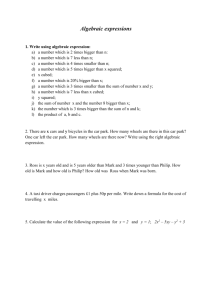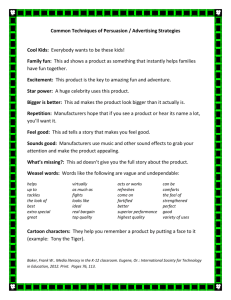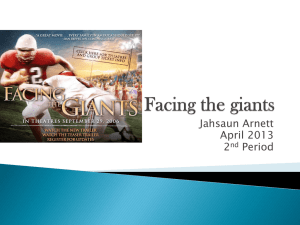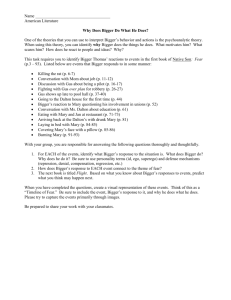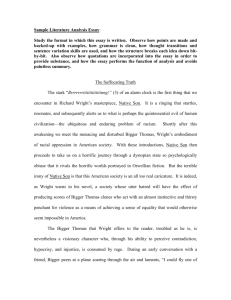Student Sample.doc
advertisement
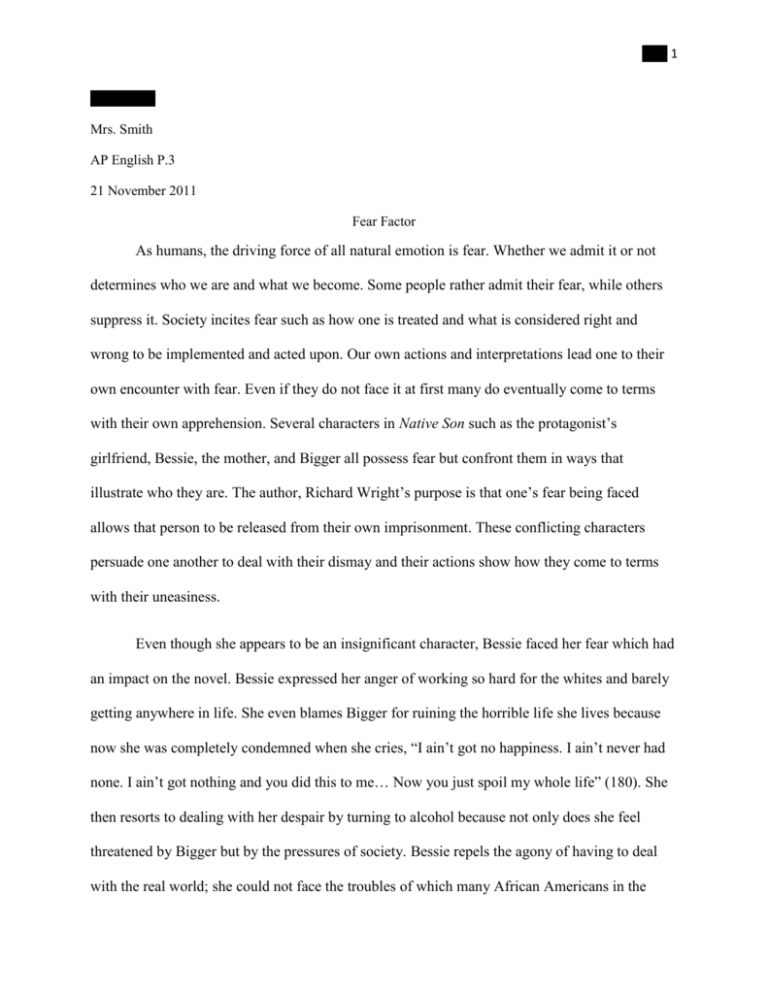
Abel 1 Janice Abel Mrs. Smith AP English P.3 21 November 2011 Fear Factor As humans, the driving force of all natural emotion is fear. Whether we admit it or not determines who we are and what we become. Some people rather admit their fear, while others suppress it. Society incites fear such as how one is treated and what is considered right and wrong to be implemented and acted upon. Our own actions and interpretations lead one to their own encounter with fear. Even if they do not face it at first many do eventually come to terms with their own apprehension. Several characters in Native Son such as the protagonist’s girlfriend, Bessie, the mother, and Bigger all possess fear but confront them in ways that illustrate who they are. The author, Richard Wright’s purpose is that one’s fear being faced allows that person to be released from their own imprisonment. These conflicting characters persuade one another to deal with their dismay and their actions show how they come to terms with their uneasiness. Even though she appears to be an insignificant character, Bessie faced her fear which had an impact on the novel. Bessie expressed her anger of working so hard for the whites and barely getting anywhere in life. She even blames Bigger for ruining the horrible life she lives because now she was completely condemned when she cries, “I ain’t got no happiness. I ain’t never had none. I ain’t got nothing and you did this to me… Now you just spoil my whole life” (180). She then resorts to dealing with her despair by turning to alcohol because not only does she feel threatened by Bigger but by the pressures of society. Bessie repels the agony of having to deal with the real world; she could not face the troubles of which many African Americans in the Abel 2 1930s were dealing with. Her feelings were often conveyed throughout her presence in the novel but the highlight of the novel was her pleading with Bigger when she said, “I wish I could kill myself… I’m scared, Bigger” (226). Her realizing that Bigger’s actions were wrong relinquished the fear and left her vulnerable. Bessie feels like she was being used by Bigger and is afraid that he will leave her. She even questions if Bigger was with Mary Dalton. Even though she was raped and brutally murdered by her boyfriend, the protagonist, she was not guilt ridden by her fear. Bessie is seen to be at peace with her decision because she had enough courage to face her fear of stepping out of the status quo and being able to stick up for herself. Her own approach of her fear allowed her to come to a realization of her being wrong and even worthless enough to consider committing suicide. Regardless of her inflicting internal thoughts, Bessie knew what she had done. She could let go of her initial fear of the white society and run away with her boyfriend Bigger. Her actions rubbed off Bigger and he began to contemplate and second guess his own actions because they were also out of fear. This did not alter who she was just how she had to deal with her own fear with coping mechanisms. Bigger’s mother dealt with fear like many did in the 1930s, with religion and faith. On the other hand, she was always talking down to Bigger and making sure he felt worthless but things began to change. Being the walking paradox, his mother could always resort to God being able to save her. Like many believers, she could explain and even find relief within the pages of her bible and praying. When Bigger was being tried for his crimes his mother has an emotional conversation with him and uses faith as a catalyst of conveying her fear. She sees that she contributed to the position he was now in and she crumbles. In a panic she immediately runs to the only things she knows, God. Seeing him for the first time after his lock up she feels guilty and says, “Listen, son, your poor old man wants you to promise her one thing… Honey, when Abel 3 ain’t nobody round you, when you alone, get on your knees and tell God everything. Ask him to guide you” (299). She resorts to God, feeling like her guilt ridden son’s only salvation is faith. Her timidity could no longer be contained and she turned to reverend Hammond to give her son guidance. Although it seems as if she is only scared for him, she also fears what would happen to her and the rest of her kids. Her pessimistic and taunting tones were perceived as pestering to Bigger but it was her fears of his future, what would become of her oldest and when it finally hit her she ran to God. This concept was brought to Bigger’s attention which was one of the leading factors of how Bigger finally facing his fear of vulnerability. Although fear should not be suppressed, the main character, Bigger, felt that his fear needed to be hidden from the human eye. Bigger cogitates his fear internally but refuses to have any one perceive him as inferior. He contemplates about how they would perceive him and ways he can change it continuously. His juvenile antics were ways he would express his fear, appearing irresponsible and ignorant to society. His suppressed angst was magnified when he killed Mary Dalton and her death released not only fear but an alternate side of Bigger. This horrific event added onto his fear and amplified it to lead him to get rid of her body effectively when it was describe, “He wanted to run from the basement and go as far as possible from the sight of this bloody throat. But he could not. He must not. He had to burn the girl.”(92).Wright constantly has Bigger fighting with himself to portray his inflictions of what he has done. After this tragedy, Bigger then convinced himself that he had to hide this fear; to the white society he could not be scared like before. Bigger’s fear transformed into irrationality but also into paranoia. As he thinks about the consequences of his actions, he feels as if he will get caught. His philosophy of many criminals getting caught because of the women they were with makes him believe that he had to get “rid “of Bessie when he thinks, “He could not take her and he Abel 4 could not leave her…so there passed before his eyes in a split second of time one of the bricks he had first come into the room”(235). Bigger killed Bessie because he was afraid that she would not go along with his plan he conjured up. But also afraid that she would find out his fear, catch a hold of it and finally be able to release it. Bigger felt that no matter what he did he would always second guess himself and end up not having enough courage to face his fear but also him having the thrill of having no fear. With his attempts of trying to face fear even with faith, he was let down when it was said, “Had the preacher trapped him? He felt betrayed. He wanted to tear the cross from his throat and throw it away” (338). Using his mother’s method of faith and Bessie’s method of alcoholism, Bigger was left with his fears bear and he needed to discover his own method of facing his fear. At the end of the novel the conversation that takes place between himself and Max, his lawyer, displays Bigger overcoming his fear when he says, “…I ain’t asking for nobody to forgive me. I ain’t going to cry… But when I think of why all the killings were, I begin to feel what I wanted, what I am…” (429). He not only faced his fear but gave in to his guilt. Throughout the novel, Bigger’s anguish gets worse and an alternate personality begins to develop because he refuses to face all these fears. This theory actually pin pointed Bigger’s uneasiness and made him believe he had gotten rid of his fear but he was just suppressing it, leading to his own downfall of execution. Bigger finally allowed these feelings to take over him and this led to his own freedom, his own salvation. One’s fear being faced allows that person to be released from their own imprisonment. Richard Wright named his first book Fear to convey his overall purpose of the novel. Doing so displays how he feels that fear is within us all but how we face then determines who we are. He utilizes fear to differentiate who the characters are and who they appear to be. Knowing that the Abel 5 hardest thing to overcome is fear, he conveys different methods of confronting one’s apprehension. Fear set the mood of the novel and even though it does not appear that fear is present it is what causes all the events to occur. Characters such as Gus, Mrs. Dalton, Mr. Dalton, Mary and many others all possess fear but the things that occur because of fear alter who they seem to be and convey who they really are. Bigger, Bessie and Bigger’s mom obtain fear but they are all altered by how they interact with each other and the events that occur in each other’s presence. Wright shows how fear can control a person and force them to do things out of their character .His main characters were used to have the reader connect to each of their fears and relate to how we all are reluctant about facing our fears. Ultimately, these characters faced their fears even if they had different ways of doing so and were finally at peace with themselves. In Native Son there are multiple characters that have to deal with fear. Even though they all dealt with it in their own way, that all intertwined with one another. Wright’s concept of overcoming the fear but facing fear was displayed throughout the novel and within several characters. Bigger conveys his fear by bottling it up and killing Bessie whereas, Bessie head on faced her fears and dealt with the consequences. Bigger’s mom went another route, through faith, that would lead to any uncertainties or explanations. Their different approaches meant that they could move on or be held back from their fates because of their fear. Calling his first book Fear, Wright was showing the reader that fear is instilled within us all but its just the way we deal with it, internally or externally that determines what would becomes of us. Abel 6 F (50-lower) D (69-60) C (79-70) B (89-80) A (100-90) Score Commentary These essays offer a well-focused and persuasive analysis on one particular aspect of Wright’s novel Native Son. Using apt and specific textual support, the essays fully explore the chosen topic and its significance to the work as a whole (its thematic connection). The final draft is flawless and makes a strong case for the writer’s interpretation of the novel. Additionally, the writer discusses the literary work with insight and understanding. The essay not only meets but exceeds all requirements set forth in the assignment. These essays offer a reasonable analysis of one particular aspect of Wright’s Native Son. The essays discuss the chosen topic and its significance to the work as a whole. While the assertions show insight and understanding, their analysis is less thorough, less perceptive, and/or less specific in supporting detail than the essays in the “A” range. These essays are generally well-written and adhere to the requirements set forth in the assignment. These essays respond to the assigned task with a plausible reading of the novel, but they tend to be superficial or underdeveloped in analysis. They often rely on plot summary that contains some analysis, implicit or explicit. Although students attempt to discuss the topic’s thematic significance, they may demonstrate a rather simplistic understanding of Native Son. Typically, these essays reveal unsophisticated thinking and development. They demonstrate adequate control of English standard conventions but may lack effective organization and be marred by surface errors. The final draft mostly adheres to all established requirements. These lower-half essays offer a less than thorough understanding of the task or a less than adequate treatment of it. They reflect an incomplete or oversimplified understanding of Native Son, or they may fail to establish the relationship between the chosen topic and its thematic significance. These essays may rely on plot summary alone or their assertions may be unsupported or even irrelevant. Sometimes wordy or repetitious, these essays may lack control over the elements of college-level composition. Although these essays make some attempt to respond to the assignment, they compound the weaknesses of the essays in the “D” range. Either the essays did not meet the length requirement or are incoherent in presenting their ideas. They may be poorly written on several counts and contain distracting errors in grammar and mechanics. Assertions regarding the chosen Native Son topics are presented with little clarity, organization, or supporting evidence. In the case of a zero, an essay was not turned in. Grade: C (76/100)
